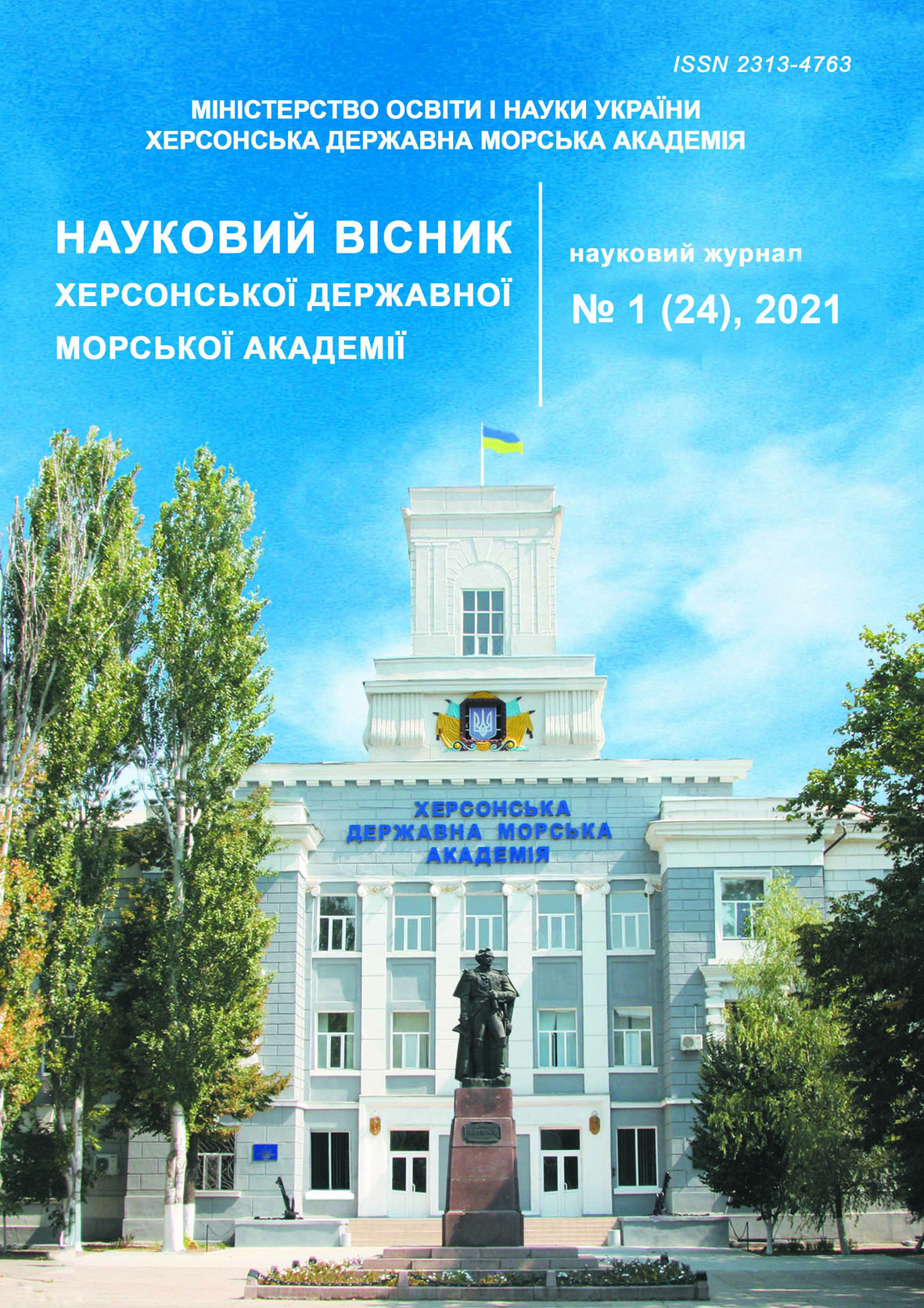APPROACHES FOR THE SUSTAINABLE MANAGEMENT OF A SYSTEM FOR SEARCH AND RESCUE AT SEA IN STATES OF EMERGENCY
10.33815/2313-4763.2021.1.24.019–028
Abstract
There is now a question of improving the search and rescue service at sea, namely its efficiency, integrity and continuity. For a long time, carrying out search and rescue operations for ships and people in distress in sea and ocean spaces was primarily the task of those who found themselves in close proximity to a vessel suffering from emergency and, of course, “You are on your own. Sink or swim”. The rapid development of scientific and technological progress, namely the development of the latest nano-bio-information-cognitive technologies (NBIC), has had a positive impact on the situation and has created a need for new concepts development and for an effective search and rescue system worldwide (SAR). Ukraine has established the Unified System for Search and Rescue of People at sea. The Unified System for Search and Rescue of People at sea is a system of bodies, organizations and enterprises that ensure the organization and implementation of search and rescue operations of people, ships and other material objects in the course of distress at sea; it carries out search and rescue activities in a certain maritime area of responsibility. The worldwide practice of search and rescue operations is indicative of their poor performance in different contingencies that arise at sea. A significant part of accidents occurs through the failure of on-board equipment or ship power plant; rupture of the ship’s hull in the event of collision with foreign mechanical objects; in addition, the sea is an environment that is a subject to various natural factors, that is, a dangerous environment associated with a lot of risks. Let us consider the search and rescue at sea on the example of the disaster of the m / v Vanessa in the Sea of Azov, which took place on January 3, 2008, the ship was sailing under the flag of Bulgaria.
References
2.Grets IS Safety of navigation of the search and rescue fleet / IS Grets. Ports of Ukraine, № 01 (113) 2012.
3. Ben A. P. Vыkhod v yskhodnuiu tochku poyska v kratchaishee vremia pry osushchestvlenyy poyskovo-spasatelnыkh operatsyi / A. P. Ben, V. N. Pliushch. Naukovyi visnyk
KhDMA. 2010. Vyp. № 1(2). S. 24 – 35.
4. Kolmohorov A. N. Osnovnыe poniatyia teoryy veroiatnostei. Moskva, 1974. 120 s.
5. Shyriaev A. N. Veroiatnost / A. N. Shyriaev. Moskva: MTsNMO, 2007. 968 s.
6. Sychkarev V. Y. Yspolzovanye v sudovozhdenyy hydrometeorolohycheskoi ynformatsyy / V. Y. Sychkarev. Nosybyrsk : HAVT, 1999. 175 s.
7. Vahushchenko L. L. Systemы avtomatycheskoho upravlenyia dvyzhenyem sudna / L. L. Vahushchenko, N. N. Tsыmbal. Odessa: Lastar, 2002. 310 s.
8. Bakulin V. N., Malkov S. Yu., Honcharov V. V., Kovalev V. I. Manahement of ensurinh the resilientse of complekh technical systems. M.: Fizmatlit. 2005. 304 p.
9. Kazak V. M. Systemni metody vidnovlennia zhyvuchosti litalnykh aparativ v osoblyvykh sytuatsiiakh u poloti. Kyiv: Naukovyi druk, 2010. 284 s.
10. Dykyi O. P. Modeli turbulentnosti povitrianykh potokiv. Mistobuduvannia ta terytorialne planuvannia:naukovo-tekhnichnyi zbirnyk. Kyiv: KNUBA, 2014. Vyp. 54. S. 151 –
155.
11. Bыzova N. L. Turbulentnost v pohranychnom sloe atmosferы / V. N. Yvanov, E. K. Harher. Lenynhrad: Hydrometeoyzdat, 1989. 263 s.
12. Solovev Yu. P. Predvarytelnыe rezultatы yzmerenyi atmosfernoi turbulentnosty nad morem / Yu. P. Solovev, V. A. Yvanov. Krym: Morskoi hydrofyzycheskyi zhurnal. 2007.
S. 42 – 61
13. Ehorov N. Y. Morskaia hmdrometeorolohyia. Kurs korablevozhdenyia T. VI / N. Y. Ehorov, Y. M. Bezuhlыi, V. A. Snezhynskyi. Lenynhrad. 1962. 524 s.
14. Savytskyi H. A. Vetrovaia nahruzka na sooruzhenyia. Moskva: Stroiyzdat. 1972. 11 s.
15. Shven N. Y. Zavysymost skorosty vetra v pryzemnom sloe ot zashchyshchennosty vetroyzmerytelnыkh pryborov. Tekhnohenno-ekolohichna bezpeka ta tsyvilnyi zakhyst. Kyiv, 2010. Vyp. 1. S. 116 – 120.
16. Krыmov Y. S. Borba za zhyvuchest sudna y spasatelnыe sredstva. Moskva : TransLyt, 2011. 431 s.
17. Repetei V. D. Poysk y spasanyia na more : uchebno-praktycheskoe posobye / Repetei V. D., Pozolotyn L. A., Torskyi V. H. Odessa : Astroprynt, 2012. –195 s.
18. Dmytryev V. Y. Ynformatsyonnыe tekhnolohyy obespechenyia sudokhodstva y ykh kompleksnoe yspolzovanye (e-NAVIGATION) : uchebn. posobye / V. Y. Dmytryev. Moskva : Morknyha, 2013. 176 s.
19. Brussard R. Prymenenye rasschytannыkh zaranee zakonov upravlenyia v rekonfyhuryruemoi systeme upravlenyia poletom / R. Brussard, D. D. Merder, N. Khalo, A. K.
Kahlaian. Perm: PNYPY, 1989. Vyp. № 2. S. 33 – 42.
20. Kazak V. N. Otsenyvanye parametrov matematycheskoi modely bespylotnoho letatelnoho apparata / V. N. Kazak, Y. A. Boiarynov. Problemy ekspluatatsii ta nadiinosti
aviatsiinoi tekhniky: zb. nauk. pr. Kyiv: KMUTsA, 1998. S. 67 – 71.
21. Tkachev V. N. Vlyianye chelovecheskoho faktora na bezopasnost moreplavanyia: uchebno-metodycheskoe posobye. Novorossyisk: yzd. «S lehkoi ruky», 2009. 73 s.
22. Topalov V. P. Chelovecheskyi faktor v sudokhodstve / Human factor in slupping: uch.- prakt. posobye / V. P. Topalov, V. H. Torskyi. Odessa: Astroprynt, 2015. 244 s.
23. Fyzyolohyia cheloveka / pod red. H. Y. Kosytskoho. Moskva : OOO «Yzdatelskyi dom Alians», 2009. 544 s.
24. Kazak V. N. Otsenyvatel dlia odnoho klassa rekonfyhuryruemыkh system upravlenyia. Visnyk KMUTsA, 1988. № 1.S. 231 – 236.
25. Kazak V. N. Doslidzhennia nadiinosti elektropostachannia svitlo-syhnalnoi systemy aerodromu / V. N. Kazak, V. Y. Neret. Visnyk TAU, Kyiv: Naukovyi Tsentr, 2001.№ 1, 44s
26. Metodyky otsenky sootvetstvyia NLHS-2. Hl. M3. Opredelenye letnыkh kharakterystyk, ustoichyvosty y upravliaemosty samoleta. M.: Transport, 1977. 183 s.






